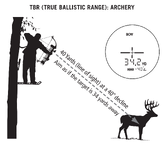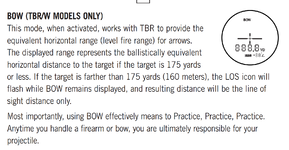I have a Leupold RX-1600i TBR/W rangefinder that I use for everything. Honestly, it probably does way more than I actually use it for...which is basically just LOS and Angle (for rifle ballistics app input) or Horizontal distance for archery. That said, the "Bow Mode" seems strange from reading the user manual and the included example: 40yds*cos(40deg)=30.6 yds=horizontal distance. The manual says 34 yds. Whats going on here? Is Leupold doing some fancy internal calculation to come up with "equivalent horizontal distance" as its referred to in the user manual? Considering the rangefinder doesn't take arrow weight or speed inputs, it seems odd they would attempt to estimate the "shoot for" distance. The cut charts for my particular arrow weight and velocity don't jive with this example either. Then again I haven't exactly been practicing much on 40 deg downhill shots to confirm.
The dimensions in the example Leupold provides seem like a pretty unlikely hunting scenario for a treestand (like the illustration shows), but seems like something a western hunter might want to understand before taking a shot based on a calculated "equivalent" distance.
Does anybody have insights? Thanks.
From user manual:


Other similar and newer rangefinders from Leupold (e.g. RX-1400i TBR/W) appear to have the same feature and stated example in the user manual.
The dimensions in the example Leupold provides seem like a pretty unlikely hunting scenario for a treestand (like the illustration shows), but seems like something a western hunter might want to understand before taking a shot based on a calculated "equivalent" distance.
Does anybody have insights? Thanks.
From user manual:


Other similar and newer rangefinders from Leupold (e.g. RX-1400i TBR/W) appear to have the same feature and stated example in the user manual.
